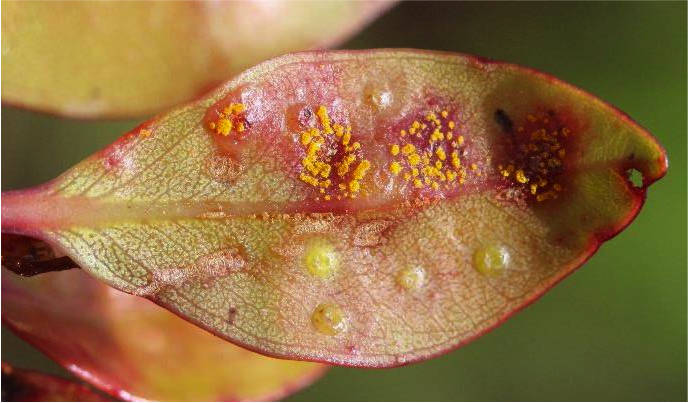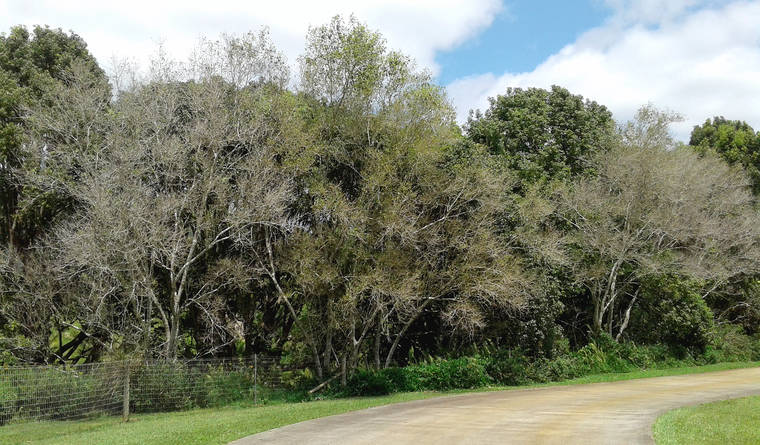WAILUA HOMESTEADS — Trees are dying in the Wailua Homestead and Kapahi areas, and though it’s not ‘ohia, some residents remain concerned.
In fact, the main trees in question are considered invasive species — the java plum, a member of the same family as ‘ohia; and the myrtle family, Myrtaceae.
Pamela Welch, a resident of the Wailua Homesteads, noticed the trees around her home have been looking unhealthy, and is asking questions.
“Although the situation is not as serious as ROD (rapid ‘ohia death), these trees are considered invasive species, their sheer numbers will create a very observable change to the island landscape,” she said.
While scientists with University of Hawaii College of Tropical Agriculture and Human Resources (CTHAR) haven’t been in the field to investigate, they agree the culprit might be Austropuccinia rust.
It’s not the fungus that causes ROD, that targets ‘ohia specifically, and hasn’t jumped to other species. Scientists have noted Austropuccinia rust has been known to attack the native ‘ohia as well, though usually not fatally.
Known also as “guava rust,” it has about 400 plant hosts and most commonly infects the myrtle family.
“(It) is the same rust disease that killed all the rose apple (mountain apple) statewide about a decade ago,” said J.B. Friday, extension forester with CTAHR. “I don’t know why the rust would hit java plum now rather than years ago.”
Friday consulted with fellow CTHAR researcher
Roshan Manandhar, Kauai extension agent with the Department of Plant and Environmental Protection Services.
Manandhar says he’s been getting reports of the rust surfacing on island since December. He agrees that’s what’s causing the defoliation of the java plum, but both scientists say it’s a bit harder to identify because the rust kills the leaves and no other sign of the pathogen appears until the leaves flush out again.
Usually, Austropuccinia is a weak pathogen, they say, especially in ‘ohia, but in 2016 there were outbreaks on Oahu and Moloaki that killed hundreds of trees.
They think that the rust outbreaks could be linked to weather.
“The fungal disease, it’s most favorable condition is rain — wet weather (that’s) moist and humid so they can grow,” Manandhar said. “If the leaf is dry, the fungal spores don’t grow. They just sit there, and once they get the moisture, they grow.”
He said the rust disease can be in a tree without symptoms for up to two months.
The rust kills slowly. Initial symptoms are purple blotches on the leaves, and then the rust appears. The leaves dry up and fall off, and that can happen three or four times within a period of two or three years before the whole branch dies. That leads to crown dieback and then eventual tree death.
Because this is happening to the invasive java plum, there is no current plan to stop the rust from taking down the trees. Scientists say it’d be better for the native forests if all of the java plum disappeared.
“If it’s in the home garden you might be unhappy because it’s been there for 20 or 30 years and you’ve been harvesting fruit from childhood,” Manandhar said. “But for now, I think we’re good. Just keep watching the java plum dying.”
The concern, however, is that it’s a different strain than the already-known guava rust.
“Until now, I haven’t been able to collect a leaf sample and send it in for a diagnosis,” Manandhar said.
Both Manandhar and Friday say they don’t know of any new pathogens on the other trees that Welch reports are dying in the Kapahi and Wailua Homesteads area, but Friday points out the biggest killer of landscaping trees is poor management — too much weed-whacking or herbicides, for example.
•••
Jessica Else, environment reporter, can be reached at 245-0452 or jelse@thegardenisland.com.




Good! All those Java Plum Trees need to die and go away!